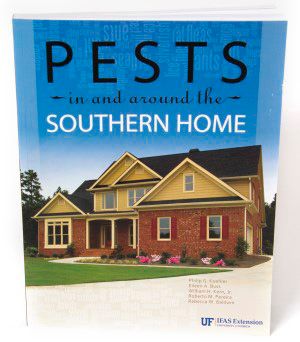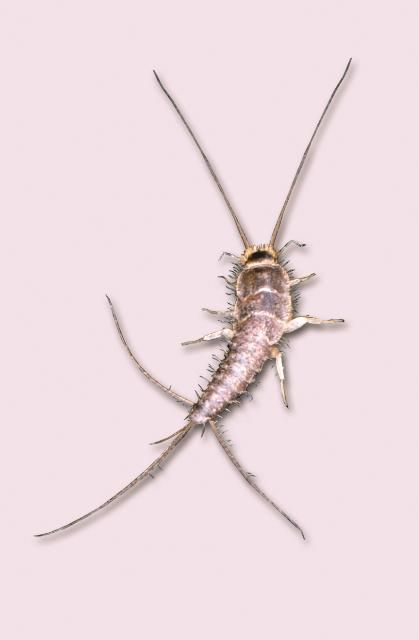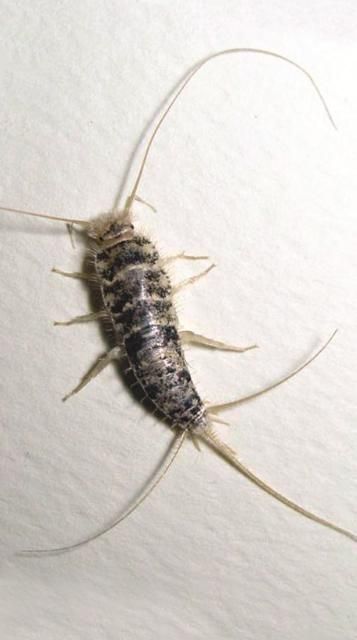
Credit: UF/IFAS
Booklice
Booklice (Figure 1) belong to a group of insects collectively called psocids. There are species that live indoors and different species that live outdoors. Psocids are small, soft-bodied insects, ranging in color from a translucent white to gray to light brown. They are usually less than 1/16 inch long (1.5 mm); however, outdoor species can be 1/4 inch (6 mm). Indoor species are commonly called “booklice” while outdoor species are often referred to as “barklice.” Psocids have long, filamentous antennae, chewing mouthparts and a bulging clypeus—the front part of the head—between the eyes.

Credit: UF/IFAS
Psocids' primary food sources are fungi, cereals, pollen, fragments of dead insects, or other similar materials. At times they may become extremely abundant and spread throughout an entire building, where they prefer warm areas with high humidity. In such situations they may contaminate foods and materials to the point the goods must be discarded. Damage to books may be more direct as they eat the starch sizing in the bindings of books and along the edges of pages.
The majority of psocids are outdoor species with well-developed wings. They are also referred to as "barklice" because they are commonly found on bark or on the foliage of trees and shrubs. Most of the species found in buildings are wingless. Because they are often found among books or papers, they are called booklice. The term "lice" in the names is somewhat misleading because none of these insects are parasites and few of them have a louselike appearance.
Biology
During the warm summer months, the psocid female can lay 50 to 60 eggs. The eggs of psocids are laid singly or in clusters and are often covered with silken webs or debris. Most species pass through six nymphal stages. The entire life span from egg to adult is between 30 and 60 days.
Control
- Discard infested food. Keep food in tightly sealed containers.
- Reduce humidity to less than 50% to slow mold growth.
- Thoroughly launder or clean furniture, bedding, or other movable furnishings.
- Vacuum or wipe down shelving where food is stored.
- Chemical control is not usually necessary once moisture has been reduced.
- If you chose to use a pesticide, follow label directions.
Silverfish and Firebrats
Check out our video on How to Deal with Silverfish! https://youtu.be/jM07lZb8dqg
Silverfish (Figure 2) and firebrats (Figure 3) belong to a group of primitive insects in the Order Zygentoma. They are wingless and have slender, carrot-shaped bodies that are covered with scales. Both insects have two long slender antennae attached to their heads and three long tail-like appendages at the hind end. Each appendage is almost as long as the body. Adults are about 1/3 to 1/2 inch long (8 to 13 mm). Silverfish are shiny and silver or pearl-gray. Firebrats are mottled gray or brown.

Credit: UF/IFAS

Credit: insectimages.com
Silverfish and firebrats are common in homes and can be found in places with high humidity and little airflow. They are active at night and hide during the day. When objects under which they hide are moved, they dart about seeking a new hiding place. Large numbers may be found in new buildings in which the newly plastered walls are still damp. Silverfish and firebrats may cause damage in the home by eating foods or other materials that are high in protein, sugar or starch. They eat cereals, moist wheat flour, paper on which there is glue or paste, sizing in paper and book bindings, starch in clothing, and rayon fabrics. In apartment buildings, the insects follow pipelines to rooms in search of food. They may be found in bookcases, around closet shelves, behind baseboards, or around windows or door frames.
Silverfish live and develop in damp, cool places. Firebrats live and develop in hot, dark places, such as around furnaces and fireplaces and in insulation around hot water or steam pipes.
Biology
Under normal house conditions, silverfish and firebrats develop slowly and have few young. Females lay eggs year-round in secluded places, such as behind books or on closet shelves; however, occasionally they lay eggs in the open.
Silverfish lay only a few eggs at a time but may lay several batches over a period of weeks. The adult female can live for two to five years depending on the species, and can lay up to 100 eggs. The eggs are whitish, oval and about 1/32 inch long (0.8 mm). They hatch in two to eight weeks.
Firebrats lay about 50 eggs, one at a time, and will lay several batches. The adult female can live for about two years and can lay thousands of eggs. The eggs are soft, white, and opaque when they are laid. They later have a yellowish tinge. Firebrat eggs hatch in about two weeks.
After hatching, the young silverfish and firebrats look like the adults except they are smaller. Both insects reach maturity in three to 24 months. Their rate of growth depends on temperature and humidity.
Control
Silverfish control can be challenging.
- Remove cardboard boxes, old newspapers, and other food sources (starch) and harborage. In bathrooms, cornstarch-based cosmetics can be a food source.
- Vacuum to physically remove both silverfish, firebrats, and food sources.
- Seal or remove hiding places. Sealing up cracks and crevices around plumbing, wall molding, and windowsills will help eliminate harborage (places for them to hide).
- Careful dusting of dry cracks and crevices with diatomaceous earth and appropriate equipment is an option. The use of fine granular baits such as Niban® - FG or Dekko Silverfish Paks (20% boric acid) may be used. Always follow pesticide label directions.